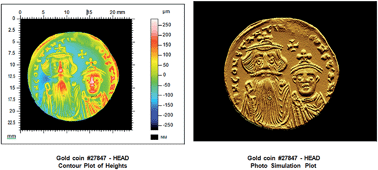The non-destructive determination of Pt in ancient Roman gold coins by XRF spectrometry
Abstract
The determination of trace concentrations of the platinum group elements in gold bullion can be significant for establishing the geographical location from which the gold was mined. Platinum is of particular importance for ancient gold as a marker of provenance. While many techniques have been used successfully to quantify Pt in a nearly pure Au matrix, wavelength dispersive X-ray Fluorescence Spectrometry (WDXRF) has not yet been evaluated for this application. This paper demonstrates that Pt can be determined in gold coins with a limit of detection of 20 μg g−1 (k = 3). Typical relative standard deviations were observed to range from 2% to 3% for Pt determined in gold coins (at 326 and 339 μg g−1, respectively). The low bias created from the imprinted coin design raising the coin up (compared to a completely flat coin piece) was largely overcome by making a 50 μm trough in the sample cup to lower the coin relative to the X-ray tube to compensate for the coin design. Determined Pt concentrations on the side of the coin with the imprinted design were within +1 to −13% of the values obtained with the opposite side where the design was removed by polishing (measured in a normal sample cup) using the same XRF method. This method was deemed fit for purpose for historians wanting to track changes in Pt concentration in ancient Roman gold coins over long time intervals.


 Please wait while we load your content...
Please wait while we load your content...